- Sail Loot Podcast 063: Sailing With FIRE on Luna Sea with Mark and Jennifer
- Sail Loot Podcast 062: Andersons Abroad own Sea-Tech Systems to make Sailing Money
- Sail Loot Podcast 048: Neil Davies Sails to Cuba and Works Remotely for Sailing Money
- Sail Loot Podcast 042: Wiley Sharp, Part 2 – Owning and Operating a Virgin Islands Sailing Charter
- Sail Loot Podcast 037: Salty Times Sailing to find the Surf with Base and Jamie
- Sail Loot Podcast 027: Couchsailors Jose and Gina Rent All of their Rooms for Sailing Money
- Sail Loot Podcast 020: Leah Kruger Makes Her Sailing Money With Brio
- Sail Loot Podcast 019: Good Anchorage, Get Paid To Cruise
- Sail Loot Podcast 013: Investing Money to Make Money While Sailing the Mediterranean with Franz Amussen
- Sail Loot Podcast 012: From Corporate America to Ottsworld with Sherry Ott
Basic Cruising Course: The Second Step To Improving Our Sailing Skills – Day Three
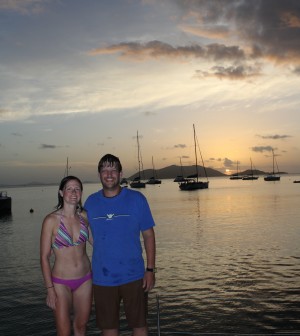
Our third day aboard Allison began a little later than the second at about 0700. At that point I was beginning to realize that the days start and end a little earlier in the tropics. The sun would start coming up and even with the shades drawn tight over the hatches, the interior of our berth would begin to brighten.
The rising sun would also start to heat things up, and I just can’t sleep when I’m hot and sticky. There were several reasons why we decided that we wouldn’t run Allison’s air conditioning throughout an entire night:
- The generator (GenSet) on Allison was kind of loud. Or, it was just situated in a terrible spot for people sleeping in the aft berths on the Lagoon 440.
- Running the GenSet uses diesel fuel. Yes, we were on vacation and the diesel was actually included in our pre-paid costs, but we like to be somewhat eco-conscious.
- Allison’s cabin and all of the berths actually cooled down quite quickly and would hold that cool air inside for several hours. It was possible to run the air conditioning for a little while, then turn it off and be comfortable for most of the evening.
- Once the sun goes down in the British Virgin Islands the temperatures actually gets to be quite pleasant. We were quite content to sleep with our hatches open if it wasn’t raining
The problem was that it would rain for at least a few minutes every night that we were there. We would have to close our hatches and when the sun came up it would get hot and bright in our berth.
I’m not complaining really. In fact, I kind of enjoyed shifting my sleep schedule. After all, a new day of sailing, snorkeling, learning, and exploring was starting. It was time to get up and enjoy it!
The coffee was percolated, we were just about finished having a small breakfast, and it was time to start our morning lesson about navigation.
Rory gathered the chart of the British Virgin Islands, dividers, a parallel rule, a compass, a few pencils, and some paper. We spent about 90 minutes going over all of the basic navigation and plotting concepts. You know, concepts like…
- reading a chart
- a minute of latitude equals 1 nm
- reading and plotting latitude and longitude positions and waypoints
- calculating speed, distance, and time
- the concepts of direction like heading and course
- plotting a course
- getting a fix using 3 stationary objects of known position
- dead reckoning
When asked if we wanted the PC or non-PC version of the mnemonics he could teach us for some of the formulas he was teaching us, we answered, “Non-PC!” of course. So, in order to convert between true, magnetic, and compass directions he gave us the age old mnemonic:
True = true North or a true heading given from the outer rose on a chart.
Virgins = Variation: The magnetic variation that applies in the area where you are.
Make = Magnetic: there is a magnetic field created by the Earth, Moon, Sun, Solar System and other celestial…this is too much science. It’s basically the magnetic heading (after you have allowed for variation) or the way the compass would point without any…
Dull = Deviation: the difference in compass readings created by the magnetic influence of other items around the compass such as iron or steel which have magnetic properties.
Companions = Compass: the actual direction that your compass is pointing.
add Whiskey = the rule when converting from True to Magnetic or Magnetic to Compass is that you ADD West variation and subtract East variation.
With our navigation lesson complete, it was time to go sailing, but first we had to learn some techniques for weighing anchor. Rory taught us a few techniques for using the windlass, moving the boat forward towards the anchor, and making sure that we didn’t foul our hull with the anchor chain.
Megan was our captain for the day. She started the engines. We weighed anchor and headed out of North Sound via the channel between Prickly Pear Island and Mosquito Island.
We raised the sails as soon as we were out of the channel and had enough water to maneuver.
Rory immediately took a GPS fix at 18 31.3N 064 22.9W. Fred had volunteered to be our navigator for the day. Other than helping to sail Allison, he was also tasked with recording data of a major event such as a direction change or major wind shift. The data that he recorded was the time of the event, our speed (or log), and our heading.
Our starting waypoint was the GPS fix that Rory had just taken. The navigation data was recorded for that waypoint and for the major events throughout the rest of our morning sail.
We started on a course of 273 degrees for about 6 NMi, changed direction to a course of 239 degrees for about 4 NMi until we rounded the North point of Great Camanoe Island, and finished up our morning sail with a 1.4 NMi sail at 191 degrees between the islands of Guana and Great Camanoe.
During our sail I had spent some time in the galley preparing lunch. When we were done with our morning sail, we dropped and furled our sails and motored onto a mooring ball at Monkey Point, the very Southwestern tip of Guana Island. Since lunch was ready, we decided to sit down and eat before going for a snorkel to cool off and explore some of the underwater life.
After our lunchtime snorkel it was time to drop our mooring ball at Monkey Point and set course for Cane Garden Bay, where we would be dropping anchor for the evening on the West side of Tortola. Megan went up to the helm, started the engines, and drove us off of the mooring. When we had enough room, Megan turned the boat into the wind, we raised the sails, and she pointed Allison on a course for our destination.
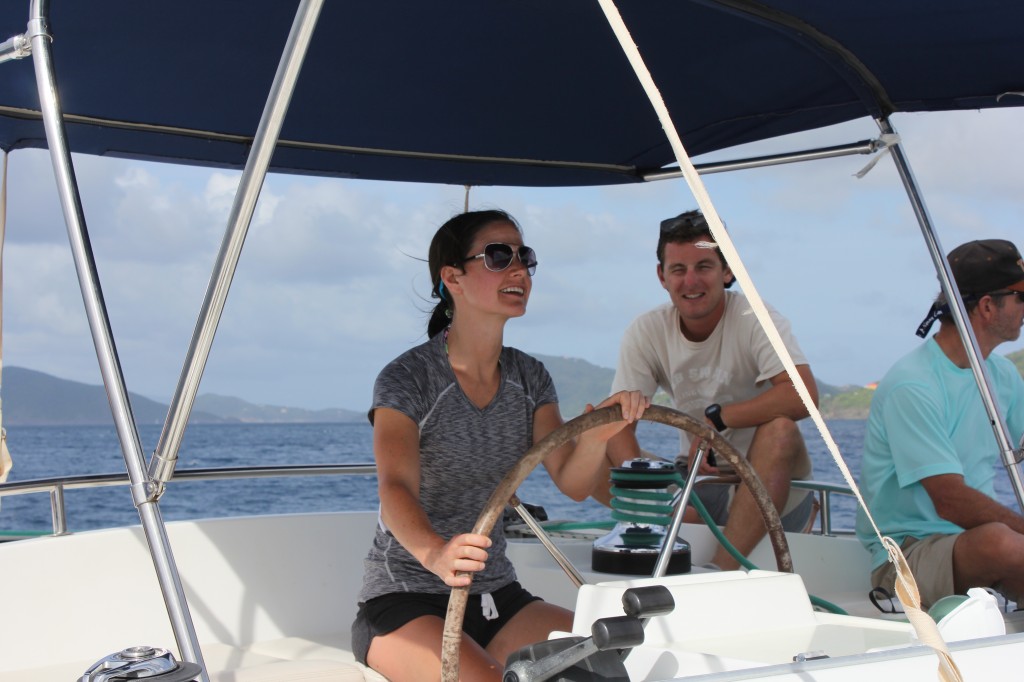
Megan sailing us on a Broad Reach on a Port Tack Through the BVI
We were on a reach during all of our sailing for the day. After all, the trade winds are from the East and we had Allison on a Westerly course almost all day. We spent most of the day on a beam or a broad reach, and we got a lot of practice jibing throughout our sail. Some of our jibes were just for practice, but others were also needed so that we could navigate around the islands.
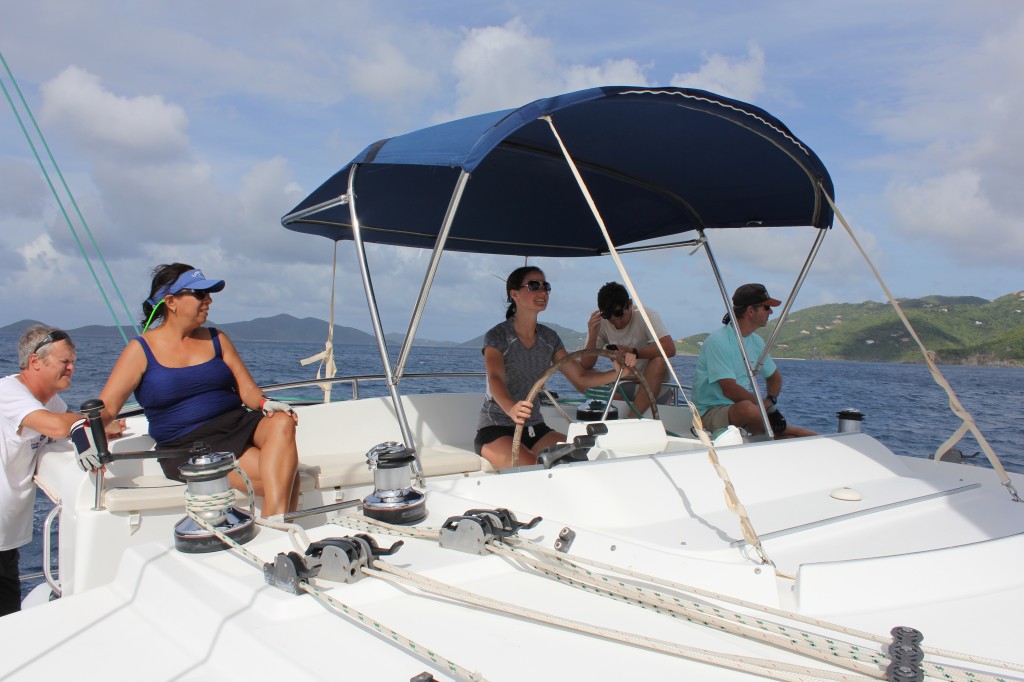
Sailing on a Broad Reach on a Port Tack BVI
Controlling the jib during a jibe isn’t so much different than during a tack. The main difference is that instead of trimming the jib sheet all the way in after a tack, you have to remember to ease the jib sheet out until its on the verge of luffing after a jibe.
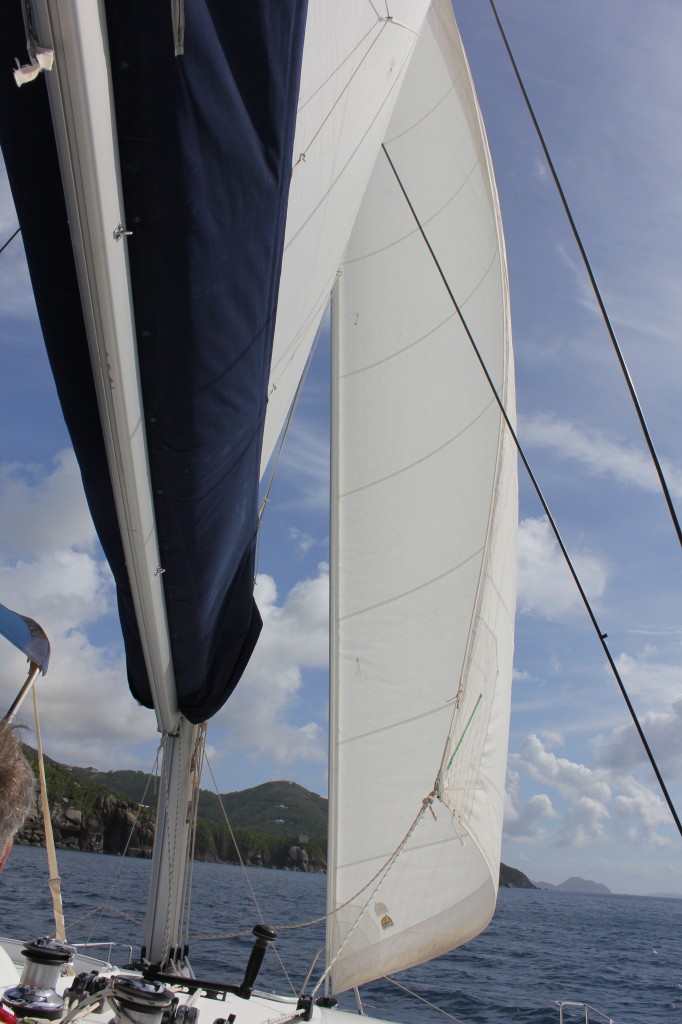
Allison’s Jib while Sailing
There are a few more steps when preparing and controlling the main sail during a jibe. You don’t want the boom to flop all the way over and slam to the other side of the boat. You also want to make sure that the traveller is in a position that allows you to get on your next point of sail. Prior to jibing, it is best to center the traveler and trim the main so that the boom is close to midline of the boat.
For example, lets say you’re on a broad reach on starboard tack. Your traveler is probably pretty far over to the port side of the boat. If you were to just leave the traveler where it is and jibe the boat, you may not be able to properly trim the main sail to the starboard side of the boat with the main sheet alone. The traveler has to move.
Prior to jibing you have to center the traveler and sheet the main. This way, the boom will not violently swing to the other side of the boat during the jibe. When the jibe is complete, the main sheet can be eased and the traveler can be moved to the other side of the boat in order to trim the main sail and get on the proper point of sail.
To finish our sailing for the day we sailed past Brewers Bay and DuBois Point. When Cane Garden Bay was to port we furled the jib, trimmed the main, made sure the topping lift was holding the boom up, turned on the engines, turned Allison head to wind and dropped the main sail. Megan drove Allison past all of the moored boats in Cane Garden Bay to our anchorage and Cindy used the windlass to drop the anchor while Fred and I counted chain length.
A successful anchorage equals rum drinks! We took a quick dip off of Allison’s stern to cool off, and we plotted our navigation data that we had gathered during our morning sail while drinking our rum drinks.
We had learned a lot in the past few days. We had learned about provisioning, packing, chartering, checklists, tacking, jibing, picking up a mooring ball, anchoring, navigation, right of way and collision avoidance, as well as reading the wind, trimming the sails, and steering the boat. It was time to take our Basic Cruising Exam!
We poured more rum drinks from the blender, grabbed some pencils, sat down in the saloon, and took our tests. This one was a little more difficult that our Basic Keelboat Exam only because there was a little more information to cover. But once again, we all passed!
We celebrated with…more rum drinks of course!
Cane Garden Bay was a beautiful anchorage. The sun set was amazing! The white sand beach was soft between our bare toes, and dinner at Quito’s Gazebo was delicious! Quito even came out and played a few songs for us!
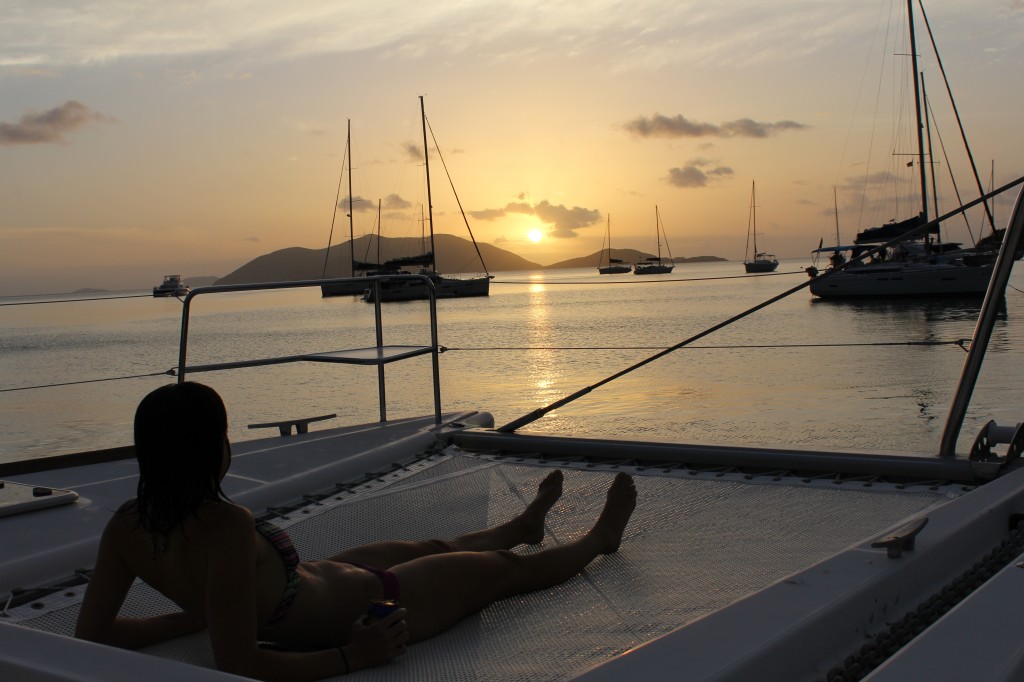
Megan Enjoying the Sunset from the Trampoline – Cane Garden Bay
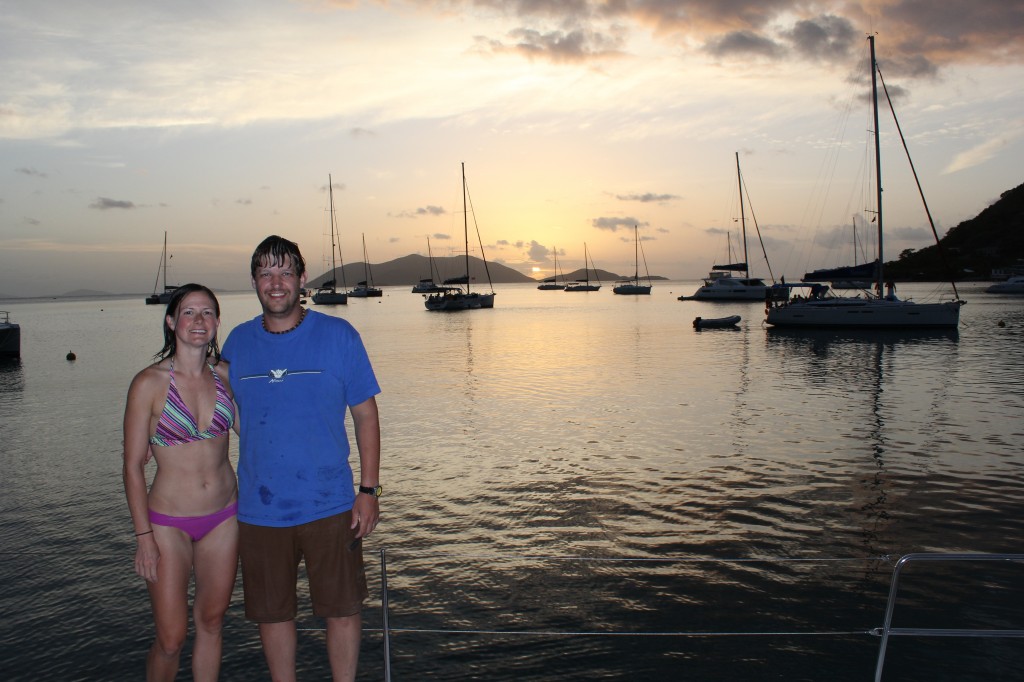
Megan and Teddy with Sun Setting Behind Jost Van Dyke – from Cane Garden Bay
Are you enjoying the stories of our sailing adventures? Leave comments below or chat with us over on our Facebook page!
TeddyJ


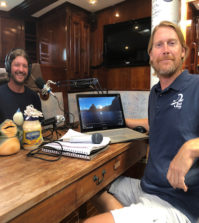
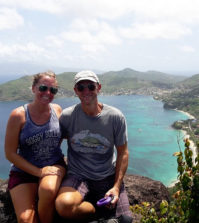
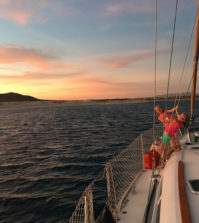
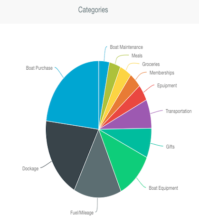
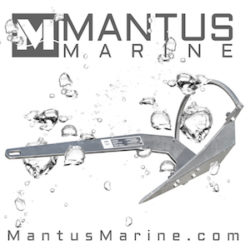

0 comments